
In many societies, religion and culture are closely linked. A civilization’s belief system impacts how its members handle many aspects of daily life. Death is no exception, with rules and rituals that vary from culture to culture. Cremation is practiced throughout the world, but each society does it for different reasons. Knowing how various groups view death provides a key to their rationale for cremating their dead.
Indian Religions: Hinduism, Jainism, and Buddhism
Many devout Hindus wish for cremation, especially in the sacred city of Varanasi. National Geographic writer Pete McBride explains that this desire comes from the belief that having one’s ashes scattered in the nearby Ganges River will allow the soul to travel directly to heaven, escaping the cycle of reincarnation.
Jains also cremate their dead, and several explanations are offered as reasons. The Encyclopedia of Death and Dying mentions that cremations in India typically happen within 24 hours of an individual’s death. This may be seen as a method for expediting the soul’s release from the body. A July 2017 India New England News piece adds that this is done to help keep the earth pure, as bodies are seen as carriers of bacteria and disease.
Tricycle contributor Mary Talbot clarifies that Buddhist funerary rites vary throughout Asia. Many opt for cremation based on the idea that the Buddha himself was cremated. In some societies, nearly everyone is cremated upon death. However, the practice is reserved only for revered spiritual leaders in Tibet and for those who’ve lived peaceful and prosperous lives in Laos.
Mesopotamian and African Views on Cremation
The ancient Egyptians considered it critically important to preserve deceased people’s bodies, especially those of royalty and other highly respected individuals. The Ancient History Encyclopedia documents the elaborate Kemetic funerary customs that included meticulous embalming procedures. Another Ancient History Encyclopedia article discloses that the Babylonians buried their dead in vaults, and the Israelites interred deceased people’s bodies in tombs whenever possible.
These cultures tended to share the belief that the body needed to be whole and protected after death, whether to journey to the afterlife or to avoid the dishonor of being defiled. Consequently, there’s little mention of cremation except in limited instances among the Phoenicians. In these cases, the custom may have been set aside for high-ranking members of society or perhaps for babies who were stillborn or died shortly after birth.
Many African societies hold similar views about cremation. Rwanda journalist Robert Mbaraga describes traditional beliefs in which the deceased go to meet their ancestors. Thus, their bodies should be left intact to permit this journey. Mbaraga adds that Christianity and Islam are practiced in large regions of the continent, resulting in a preference to bury their dead.
Pre-Christian European Customs
The Encyclopedia Britannica gives a quick overview of cremation practices in pre-Christian Europe. The ancient Greeks were among the first to include it in their funerary traditions. They still buried some of their dead, but highly respected individuals and warriors were cremated. The Romans followed suit, cremating their military heroes. Old Norse civilizations also preferred to cremate their dead, believing that it prevented them from resurrecting and causing harm.
A Wide Range of Traditions in the Americas
Funerary customs differ widely among American Indigenous cultures. For example, Aztec rulers were cremated while commoners were usually buried. Navajos desire to inter their deceased as quickly as possible to prevent their spirits from lingering. Burial was also widely practiced in cultures like the Ojibwe and the Cherokee, while the Inca opted to mummify their dead.
Each civilization’s funerary customs offer interesting clues about its cherished values. Impacted by factors such as class distinctions, spiritual beliefs, and hygienic concerns, how each civilization treats its dead is one reflection of its heart and soul.

